Butterfly: Powerful Ancient Symbol Of Beauty, Transformation, Hope, Rebirth And Happiness Featured In Myths And Legends
A. Sutherland - AncientPages.com - Insects have always accompanied humans; some of them have gained a special place in culture and mythology. A butterfly has deep roots in the early beliefs of ancient people around the world, and many myths and legends feature this fantastic insect.
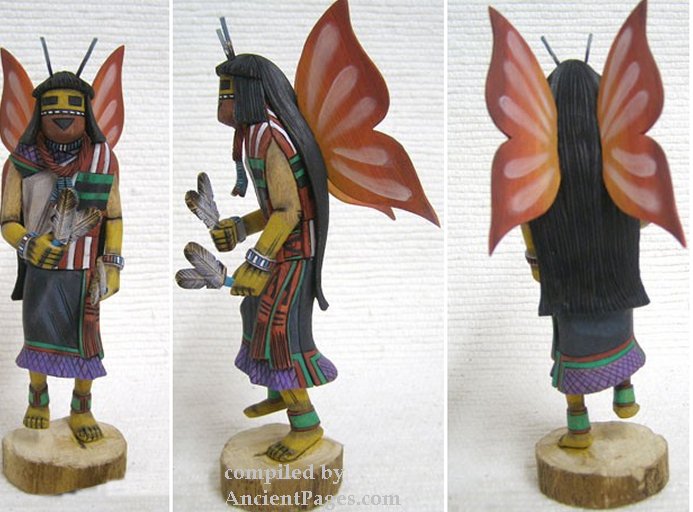 Native American Hopi Carved Butterfly Maiden Kachina Doll. Credit: kachinahouse
Native American Hopi Carved Butterfly Maiden Kachina Doll. Credit: kachinahouse
A good example can be the butterflies, one of the most beautiful insects that symbolize the day and female beauty.
The butterfly has been a symbol in almost every culture of transformation and rebirth. The butterfly experience many changes, starting its life in one form and ends in another. Ancient people (and perhaps also modern ones) have long believed that our souls transform. The ancient Romans believed that a butterfly symbolized the soul, and butterflies often adorned old tombstones.
Importance Of Butterfly Among Native Americans
For many Native American tribes, the appearance of a butterfly announces beautiful weather and good luck. However, butterflies play a variety of other roles in folktales of these people depending on the tribe. Sometimes, butterflies represent balance and change; other folktales emphasize their beauty, vanity, and playful behavior. Some Native America tribes had taboos against killing these insects. Likewise, among ancient Irish beliefs, there was one saying that in white butterflies dwelled the souls of young children.
The killing of such a butterfly had significant and very negative consequences.
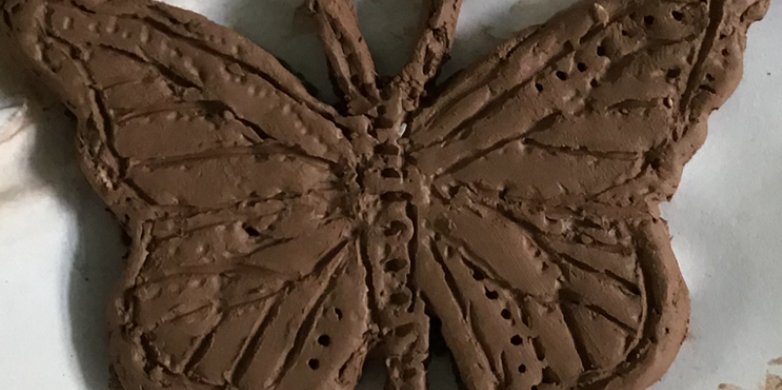 For the Greeks, the butterfly was the symbol of the soul or psyche. source
For the Greeks, the butterfly was the symbol of the soul or psyche. source
Blackfoot people of Saskatchewan, Alberta, and British Columbia, and the U.S. state of Montana, strongly associate butterflies with sleep and dreaming, and butterfly designs were used to decorate cradleboards and other children's objects to help them sleep and experience pleasant dreams.
For the Aztecs, the butterfly was associated with women who had died in childbirth. Such women were honored with the same praise as the Aztec warriors who lost their lives in combat. The monarch butterfly represented the souls of deceased children who return to earth. The Aztecs saw the image of a human face in the insect’s wing motif, and in times of Teotihuacan's greatness, seals and headdresses were adorned with it.
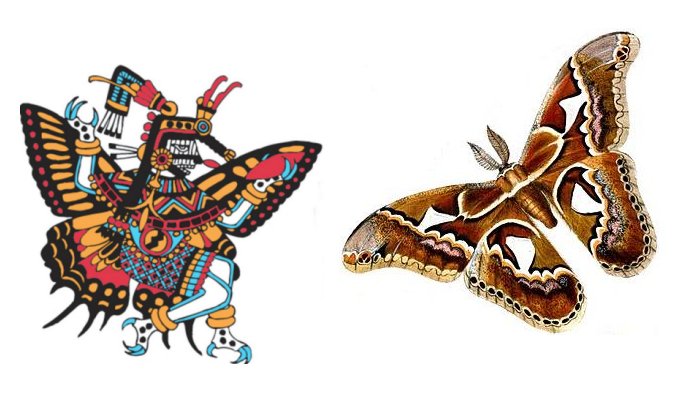 In Aztec mythology, Itzpapalotl ("Obsidian Butterfly") was a skeletal warrior goddess who ruled over the world of Tamoanchan, the paradise of victims of infant mortality and the place identified as where humans were created. source source2
In Aztec mythology, Itzpapalotl ("Obsidian Butterfly") was a skeletal warrior goddess who ruled over the world of Tamoanchan, the paradise of victims of infant mortality and the place identified as where humans were created. source source2
Butterflies were also associated with fire; their swarming together resembles a dance giving associations with the flames of a bonfire.
Hopi And 'Butterfly Dance'
Irish folklore attributes butterflies the ability to penetrate between worlds, and the Indians of South America believed that if someone could count the spots on the wings of the most numerous variety of butterflies there, they would find out how much money they would make in their lives.
Among the Hopi in North America, the butterfly is one of the animals of the creator, and so they perform beautiful 'Butterfly Dance' in honor of the butterfly Kachina. The Butterfly Maiden, called Palhik Mana, appears in August when butterflies appear in Arizona. The ceremony is held as a thanksgiving for the corn harvest, and the maidens represent the butterflies that pollinate the corn, helping to bring the crop.
Butterflies Are The Returning Souls Of The Dead
For the Maori, however, the butterfly is a symbol of longevity and immortality while the aborigines of Australia believe that butterflies are the returning souls of the dead.
For the Greeks, the butterfly was the symbol of the soul or psyche. The story of the soul's transformation from human to immortal status is told in the tale of Eros and Psyche.
For the Chinese, the butterfly is the emblem of immortality, joy, and leisure. Its depictions with the plum mean longevity; when it is illustrated with the chrysanthemum plant (know in China since at least 500 BC) it portrays beauty in old age. The butterfly also means a young man in love; however, if the woman he loves dies, she may be represented coming out of her grave as a butterfly.
In Japan, ancient people had both positive and negative associations with the butterfly, which symbolized a dishonest lover, a vain woman, or a geisha who stays with no husband but is available to man after man. This insect was often viewed as a bad omen, but it also had a positive meaning: two butterflies dancing together was a sign of happy love and happiness in marriage.
Butterfly – Christian Symbol Of Resurrection Of All Men
In Christian iconography, the butterfly is sometimes shown in paintings of Christ Child and the Virgin, particularly in the Child's hand, and symbolizes not only Jesus' resurrection but also the resurrection of all men.
It has clear associations with the butterfly's three stages of life: the caterpillar, the chrysalis, and the butterfly. At the same time, these three stages mean human life, death, and resurrection.
Written by - A. Sutherland - AncientPages.com Senior Staff Writer
Copyright © AncientPages.com All rights reserved. This material may not be published, broadcast, rewritten or redistributed in whole or part without the express written permission of AncientPages.com
Expand for referencesReferences:
Ferguson G. Signs and Symbols in Christian Art
Matthews, Caitlin. The Element Encyclopedia of Magical Creatures
Lake-Thom B. Spirits of the Earth
More From Ancient Pages
-
 6 Ancient Minorities That Intrigue Scientists
Civilizations | Apr 26, 2024
6 Ancient Minorities That Intrigue Scientists
Civilizations | Apr 26, 2024 -
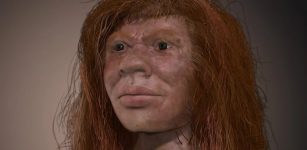 Mysterious Denny – 90,000-Year-Old Child Whose Parents Were Two Different Human Species
Featured Stories | Jul 25, 2023
Mysterious Denny – 90,000-Year-Old Child Whose Parents Were Two Different Human Species
Featured Stories | Jul 25, 2023 -
 Lost Ancient Texts Of The Star Catalogue Composed By The Greek Astronomer Hipparchus Found
News | Feb 21, 2023
Lost Ancient Texts Of The Star Catalogue Composed By The Greek Astronomer Hipparchus Found
News | Feb 21, 2023 -
 Ancient Tradition And True Meaning Of Candy Canes
Christmas Traditions | Dec 26, 2024
Ancient Tradition And True Meaning Of Candy Canes
Christmas Traditions | Dec 26, 2024 -
 Re-Evaluation Of Liujiang Skeleton’s Dating Sheds New Light On Human Occupation In China
Fossils | May 27, 2024
Re-Evaluation Of Liujiang Skeleton’s Dating Sheds New Light On Human Occupation In China
Fossils | May 27, 2024 -
 Secrets Of The Lost Tomb X – Mysterious Manuscripts And Strange Engravings – Part 1
Featured Stories | Apr 9, 2019
Secrets Of The Lost Tomb X – Mysterious Manuscripts And Strange Engravings – Part 1
Featured Stories | Apr 9, 2019 -
 Thermopolium – Ancient Roman Restaurant Offered Fast Food But Was It A Good Idea To Eat There?
Ancient History Facts | Mar 16, 2018
Thermopolium – Ancient Roman Restaurant Offered Fast Food But Was It A Good Idea To Eat There?
Ancient History Facts | Mar 16, 2018 -
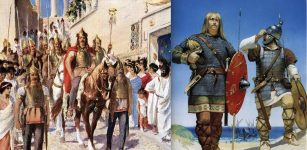 Who Were The Goths And Where Did They Come From?
Civilizations | Apr 16, 2019
Who Were The Goths And Where Did They Come From?
Civilizations | Apr 16, 2019 -
 Archaeologists Unearthed Shrine To Apostle Peter In Israel’s Galilee
Archaeology | Aug 2, 2019
Archaeologists Unearthed Shrine To Apostle Peter In Israel’s Galilee
Archaeology | Aug 2, 2019 -
 New Method Distinguishes Between Egyptian And Palestinian Glass During Roman Times
Archaeology | Jul 13, 2020
New Method Distinguishes Between Egyptian And Palestinian Glass During Roman Times
Archaeology | Jul 13, 2020 -
 Arian Tower: Pyramid-Shaped Mausoleum Of Nobleman Was Built On Top Of Medieval Hill Fort
Archaeology | May 19, 2018
Arian Tower: Pyramid-Shaped Mausoleum Of Nobleman Was Built On Top Of Medieval Hill Fort
Archaeology | May 19, 2018 -
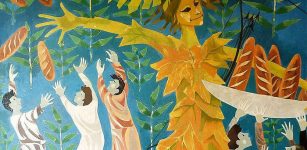 Jack o’ Legs – The Kind Hertfordshire Giant Who Robbed The Rich And Gave To The Poor
Featured Stories | Sep 20, 2021
Jack o’ Legs – The Kind Hertfordshire Giant Who Robbed The Rich And Gave To The Poor
Featured Stories | Sep 20, 2021 -
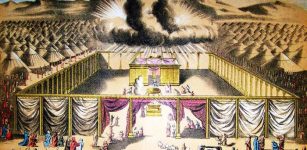 Ten Ancient Jugs And Shiloh May Reveal The Location Of The Biblical Tabernacle
Artifacts | Feb 6, 2019
Ten Ancient Jugs And Shiloh May Reveal The Location Of The Biblical Tabernacle
Artifacts | Feb 6, 2019 -
 Ancient Secrets Of Mistletoe – Sacred Celtic Plant With Magical Powers
Ancient Traditions And Customs | Dec 17, 2024
Ancient Secrets Of Mistletoe – Sacred Celtic Plant With Magical Powers
Ancient Traditions And Customs | Dec 17, 2024 -
 Strange Story Of Tecumseh’s Comet, Black Sun Prophecy And New Madrid Earthquakes – The Biggest Earthquakes In American History
Featured Stories | Nov 14, 2018
Strange Story Of Tecumseh’s Comet, Black Sun Prophecy And New Madrid Earthquakes – The Biggest Earthquakes In American History
Featured Stories | Nov 14, 2018 -
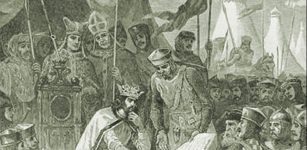 On This Day In History: Magna Carta Sealed By King John Of England – On June 15, 1215
News | Jun 15, 2016
On This Day In History: Magna Carta Sealed By King John Of England – On June 15, 1215
News | Jun 15, 2016 -
 Biblical Event Verified By Study Of Earth’s Magnetic Field?
Archaeology | Jan 4, 2024
Biblical Event Verified By Study Of Earth’s Magnetic Field?
Archaeology | Jan 4, 2024 -
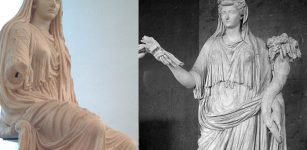 World’s First Diva Was Livia – Wife Of Emperor Augustus
Ancient History Facts | Aug 2, 2016
World’s First Diva Was Livia – Wife Of Emperor Augustus
Ancient History Facts | Aug 2, 2016 -
 Magnificent Alsengem Among 30,000 Archaeological Objects Discovered In Kalmar, Sweden
Artifacts | Mar 5, 2024
Magnificent Alsengem Among 30,000 Archaeological Objects Discovered In Kalmar, Sweden
Artifacts | Mar 5, 2024 -
 2,000-Year-Old Celtic Dice Discovered In Poland
Archaeology | Oct 11, 2023
2,000-Year-Old Celtic Dice Discovered In Poland
Archaeology | Oct 11, 2023
